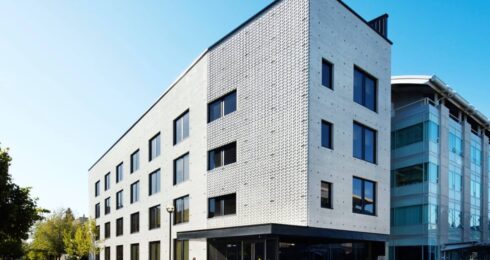Pictured: View of downtown Vancouver through haze, smog. Image source: Shutterstock.
,
One way to reduce greenhouse gas emissions and reduce industrial carbon footprints may be to convert carbon dioxide (CO2) into something useful, and a team of researchers led by Curtis Berlinguette, Professor in UBC’s Department of Chemistry and Department of Chemical and Biological Engineering, have been working to directly use carbon capture solutions (e.g., potassium bicarbonate—KHCO3—which is a relatively low-energy solution to removing CO2) replacing conventional CO2 and producing other chemicals and fuels.
,
Bill Zhang, a postdoctoral fellow in Berlinguette’s team, works with a bicarbonate conversion reaction in a closed flow cell in order to try to mimic an industrial reactor.
,
“In order to reduce CO2 to value-added chemicals, we need to find a catalyst that produces a consistent, stable reaction with desirable results,” said Zhang. “Different catalysts produce different results.”
,
Results could include reduced emissions, and more efficient energy production.
,
In order to better understand the reaction, Zhang and colleagues built a custom flow cell made out of stainless steel with a clear window, allowing them to measure the pH of the catalyst inside the flow cell. It is important to know the pH because it affects reaction and concentration of chemicals inside the flow cell. The team monitored activity within the cell using spectroscopy to probe inside; the result is a proof-of-concept study based on the pH at the catalyst surface, and informed by the respective concentrations of bicarbonate and carbonate.
,
“The concentration would vary depending on pH; we would measure, and then work backwards to see what happened, modifying temperature and other variables in order to pin down the parameters and determine how the catalyst would act under different conditions,” said Zhang.
,
The paper was published recently in the journal ACS Energy Letters.
,
“These measurements have been done in other studies using computer modelling,” said Zhang, “but our paper offers experimental data to support previous hypotheses; we have verified that these models are effective. While we are not surprised by the outcomes, we are satisfied that our work provides an experimental context for earlier research.”
,
In 2018, Canada’s total greenhouse gas (GHG) emissions totalled 729 megatonnes of carbon dioxide (CO2) equivalent, an increase of more than 20% since 1990, largely as a result of increased emissions from mining, oil and gas production, and transportation. Canada’s current target is to reduce harmful emissions by 30% relative to 2005 levels. In response to the urgency of climate change, researchers have been looking at converting harmful CO2, taking the useful elements of CO2 at the source of these emissions and repurposing for other uses while eliminating the impact of GHGs on the environment.
,
The work builds on a June 2019 paper, published in Joule, that demonstrated how Berlinguette and colleagues used a carbon capture solution to efficiently transform captured carbon dioxide into carbon monoxide, a stable, industrial gas.


